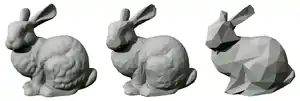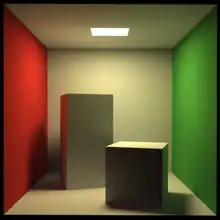
Computer graphics is a sub-field of computer science which studies methods for digitally synthesizing and manipulating visual content. Although the term often refers to the study of three-dimensional computer graphics, it also encompasses two-dimensional graphics and image processing.
Overview
Computer graphics studies manipulation of visual and geometric information using computational techniques. It focuses on the mathematical and computational foundations of image generation and processing rather than purely aesthetic issues. Computer graphics is often differentiated from the field of visualization, although the two fields have many similarities.
Connected studies include:
- Applied mathematics
- Computational geometry
- Computational topology
- Computer vision
- Image processing
- Information visualization
- Scientific visualization
Applications of computer graphics include:
History
There are several international conferences and journals where the most significant results in computer graphics are published. Among them are the SIGGRAPH and Eurographics conferences and the Association for Computing Machinery (ACM) Transactions on Graphics journal. The joint Eurographics and ACM SIGGRAPH symposium series features the major venues for the more specialized sub-fields: Symposium on Geometry Processing,[1] Symposium on Rendering, Symposium on Computer Animation,[2] and High Performance Graphics.[3]
As in the rest of computer science, conference publications in computer graphics are generally more significant than journal publications (and subsequently have lower acceptance rates).[4][5][6][7]
Subfields
A broad classification of major subfields in computer graphics might be:
- Geometry: ways to represent and process surfaces
- Animation: ways to represent and manipulate motion
- Rendering: algorithms to reproduce light transport
- Imaging: image acquisition or image editing
Geometry

The subfield of geometry studies the representation of three-dimensional objects in a discrete digital setting. Because the appearance of an object depends largely on its exterior, boundary representations are most commonly used. Two dimensional surfaces are a good representation for most objects, though they may be non-manifold. Since surfaces are not finite, discrete digital approximations are used. Polygonal meshes (and to a lesser extent subdivision surfaces) are by far the most common representation, although point-based representations have become more popular recently (see for instance the Symposium on Point-Based Graphics).[8] These representations are Lagrangian, meaning the spatial locations of the samples are independent. Recently, Eulerian surface descriptions (i.e., where spatial samples are fixed) such as level sets have been developed into a useful representation for deforming surfaces which undergo many topological changes (with fluids being the most notable example).[9]
Geometry subfields include:
- Implicit surface modeling – an older subfield which examines the use of algebraic surfaces, constructive solid geometry, etc., for surface representation.
- Digital geometry processing – surface reconstruction, simplification, fairing, mesh repair, parameterization, remeshing, mesh generation, surface compression, and surface editing all fall under this heading.[10][11][12]
- Discrete differential geometry – a nascent field which defines geometric quantities for the discrete surfaces used in computer graphics.[13]
- Point-based graphics – a recent field which focuses on points as the fundamental representation of surfaces.
- Subdivision surfaces
- Out-of-core mesh processing – another recent field which focuses on mesh datasets that do not fit in main memory.
Animation
The subfield of animation studies descriptions for surfaces (and other phenomena) that move or deform over time. Historically, most work in this field has focused on parametric and data-driven models, but recently physical simulation has become more popular as computers have become more powerful computationally.
Animation subfields include:
- Performance capture
- Character animation
- Physical simulation (e.g. cloth modeling, animation of fluid dynamics, etc.)
Rendering

Rendering generates images from a model. Rendering may simulate light transport to create realistic images or it may create images that have a particular artistic style in non-photorealistic rendering. The two basic operations in realistic rendering are transport (how much light passes from one place to another) and scattering (how surfaces interact with light). See Rendering (computer graphics) for more information.
Rendering subfields include:
- Transport describes how illumination in a scene gets from one place to another. Visibility is a major component of light transport.
- Scattering: Models of scattering (how light interacts with the surface at a given point) and shading (how material properties vary across the surface) are used to describe the appearance of a surface. In graphics these problems are often studied within the context of rendering since they can substantially affect the design of rendering algorithms. Descriptions of scattering are usually given in terms of a bidirectional scattering distribution function (BSDF). The latter issue addresses how different types of scattering are distributed across the surface (i.e., which scattering function applies where). Descriptions of this kind are typically expressed with a program called a shader. (There is some confusion since the word "shader" is sometimes used for programs that describe local geometric variation.)
- Non-photorealistic rendering
- Physically based rendering – concerned with generating images according to the laws of geometric optics
- Real-time rendering – focuses on rendering for interactive applications, typically using specialized hardware like GPUs
- Relighting – recent area concerned with quickly re-rendering scenes
Notable researchers
- Arthur Appel
- James Arvo
- Brian A. Barsky
- Jim Blinn
- Jack E. Bresenham
- Loren Carpenter
- Edwin Catmull
- James H. Clark
- Robert L. Cook
- Franklin C. Crow
- Paul Debevec
- David C. Evans
- Ron Fedkiw
- Steven K. Feiner
- James D. Foley
- David Forsyth
- Henry Fuchs
- Andrew Glassner
- Henri Gouraud (computer scientist)
- Donald P. Greenberg
- Eric Haines
- R. A. Hall
- Pat Hanrahan
- John Hughes
- Jim Kajiya
- Takeo Kanade
- Kenneth Knowlton
- Marc Levoy
- Martin Newell (computer scientist)
- James O'Brien
- Ken Perlin
- Matt Pharr
- Bui Tuong Phong
- Przemyslaw Prusinkiewicz
- William Reeves
- David F. Rogers
- Holly Rushmeier
- Peter Shirley
- James Sethian
- Ivan Sutherland
- Demetri Terzopoulos
- Kenneth Torrance
- Greg Turk
- Andries van Dam
- Henrik Wann Jensen
- Gregory Ward
- John Warnock
- J. Turner Whitted
- Lance Williams
Applications for their use
Bitmap Design / Image Editing
Vector drawing
Architecture
Video editing
Sculpting, Animation, and 3D Modeling
Digital composition
Rendering
- V-Ray
- RedShift
- RenderMan
- Octane Render
- Mantra
- Lumion (Architectural visualization)
Other applications examples
See also
References
- ↑ "geometryprocessing.org". geometryprocessing.org. Retrieved 2014-05-01.
- ↑ Archived March 14, 2007, at the Wayback Machine
- ↑ "High Performance Graphics". highperformancegraphics.org.
- ↑ "Best Practices Memo". Cra.org. Archived from the original on 2014-05-02. Retrieved 2014-05-01.
- ↑ "Choosing a venue: conference or journal?". People.csail.mit.edu. Retrieved 2014-05-01.
- ↑ "Graphics/vision publications acceptance rates statistics". vrlab.epfl.ch. Retrieved 2014-05-01.
- ↑ An extensive history of computer graphics can be found at this page Archived April 5, 2007, at the Wayback Machine.
- ↑ "Point Based Graphics 2007 - PBG07". Graphics.ethz.ch. Retrieved 2014-05-01.
- ↑ "Ron Fedkiw". graphics.stanford.edu. Retrieved 2014-05-01.
- ↑ Archived February 14, 2007, at the Wayback Machine
- ↑ CS 598: Digital Geometry Processing (Fall 2004) Archived 2004-10-25 at archive.today
- ↑ "Digital Geometry Processing". cs.ubc.ca. Retrieved 2014-05-01.
- ↑ "Discrete Differential Geometry". ddg.cs.columbia.edu. Retrieved 2014-05-01.
Further reading
- Foley et al. Computer Graphics: Principles and Practice.
- Shirley. Fundamentals of Computer Graphics.
- Watt. 3D Computer Graphics.
External links
- A Critical History of Computer Graphics and Animation
- History of Computer Graphics series of articles
Industry
Industrial labs doing "blue sky" graphics research include:
Major film studios notable for graphics research include:
